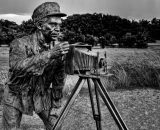- Forum
- General Discussion | Introductions | Off Topic Forum
- Photography General Discussion
- Which is film?, which is Digital?..oh the fun is about to begin.
Which is film?, which is Digital?..oh the fun is about to begin.
Post #200192
The only thing so far that occurs to me as a possibility is that the images are enlargements of part of a photo and in the process of enlarging them digitally, they both show a bit of pixelating. As Karl said, film can be more or less grainy depending on the film and the lighting conditions but the grain isn't the shape of pixels. So I'm not sure how a film image could end up with any pixelating as it's just not there in a film negative or print.
Sharon
-

- Colourful Photography
- Has the Hang of it
- Canon
- Followers: 4
- Posts: 65
-
Points:
0
Post #200338
Us film camera lovers know that digital is inferior when it comes to edges and dynamic range and such. Sure printers print in a series of dots these days, but we don't let that stop us.
I'm colour blind, but it doesn't keep me from exploring the wonderfully colourful world around us.
-
 Topic Author
Topic Author
- Scotty
- Agent 007
- James Bond, PT mod.
- Followers: 1088
- Posts: 9873
-
Points:
14814
Post #200363
Colourful Photography wrote: After careful analysis of the pictures, I deem the second one's pixelated noise to be a result of the compression that this site puts on photos and nothing to do with the scanning.
Us film camera lovers know that digital is inferior when it comes to edges and dynamic range and such. Sure printers print in a series of dots these days, but we don't let that stop us.
When the last candle has been blown out
and the last glass of champagne has been drunk
All that you are left with are the memories and the images-David Cooke.
-

- Karl Wertanen
- The Lounger
-
- Mamiya 7II Medium Format 6x7 Rangefinder Film Camera, Mamiya RZ67 Pro II Medium Format 6x7 Film Camera, and a few Minlolta Maxxum 35mm Film cameras
- Followers: 220
- Posts: 1342
-
Points:
10
Post #200405
Scotty wrote:
Colourful Photography wrote: After careful analysis of the pictures, I deem the second one's pixelated noise to be a result of the compression that this site puts on photos and nothing to do with the scanning.
Us film camera lovers know that digital is inferior when it comes to edges and dynamic range and such. Sure printers print in a series of dots these days, but we don't let that stop us.

Nice!!!!!!
-
 Pt+
Pt+ - Alex
- PT Founder
-
- Canon EOS R5 | EOS R | M6 II
- Followers: 1795
- Posts: 4785
-
Points:
48941
Post #200408
Scotty wrote:
Alex wrote: I'm saying both shots with same camera that has some debris on sensor
I uploaded the same one twice on accident...zenfolio was being weird. Updated, now there's two different ones up.
Try again!
Ah ha! Cool shot Scotty... where was this taken?
Thank you for making PhotographyTalk.com your photography community of choice.
-

- Henry Peach
- Apprentice
-
- I currently use a 5DII or Sony Nex-3 most of the time.
- Followers: 50
- Posts: 2925
-
Points:
16
Post #200520
This sort of example doesn't tell us as much about the intrinsic properties of film and digital as it does the difference in the photographer's or photographers' skills and resources when it comes to an all digital workflow vs a hybrid film/digital workflow. It shows me that Scotty and his friend appear to be quite competent with either.
-

- McBeth Photography
- Photo Guru
-
- Sinar Norma 4x5
- Followers: 365
- Posts: 3870
-
Points:
1295
Post #200522
Henry Peach wrote: As we are viewing the photos online they must both be digital photographs. One is a digital photo taken with a portable digital camera at the actual subject location. The other is a digital photo of the film original taken with a non-portable digital camera. With a good digital processing skill set it should be possible to make small examples like we see here indistinguishable from each other by the typical photo viewer.
This sort of example doesn't tell us as much about the intrinsic properties of film and digital as it does the difference in the photographer's or photographers' skills and resources when it comes to an all digital workflow vs a hybrid film/digital workflow.
It is what it is.
-
 Topic Author
Topic Author
- Scotty
- Agent 007
- James Bond, PT mod.
- Followers: 1088
- Posts: 9873
-
Points:
14814
Post #200616
Henry Peach wrote: As we are viewing the photos online they must both be digital photographs. One is a digital photo taken with a portable digital camera at the actual subject location. The other is a digital photo of the film original taken with a non-portable digital camera. With a good digital processing skill set it should be possible to make small examples like we see here indistinguishable from each other by the typical photo viewer.
This sort of example doesn't tell us as much about the intrinsic properties of film and digital as it does the difference in the photographer's or photographers' skills and resources when it comes to an all digital workflow vs a hybrid film/digital workflow. It shows me that Scotty and his friend appear to be quite competent with either.
You sir are wrong. Both were shot on location. One shot is not a portable cam taking a picture of a film picture.
P.S. I don't believe I'm competent either.
When the last candle has been blown out
and the last glass of champagne has been drunk
All that you are left with are the memories and the images-David Cooke.
-

- photobod
- Paparazzi
-
- Nikon D800 + D300
- Followers: 563
- Posts: 8907
-
Points:
150
Post #200681
www.dcimages.org.uk
"A good photograph is one that communicate a fact, touches the heart, leaves the viewer a changed person for having seen it. It is, in a word, effective." - Irving Penn
-

- Karl Wertanen
- The Lounger
-
- Mamiya 7II Medium Format 6x7 Rangefinder Film Camera, Mamiya RZ67 Pro II Medium Format 6x7 Film Camera, and a few Minlolta Maxxum 35mm Film cameras
- Followers: 220
- Posts: 1342
-
Points:
10
Post #200755
Scotty wrote:
Henry Peach wrote: As we are viewing the photos online they must both be digital photographs. One is a digital photo taken with a portable digital camera at the actual subject location. The other is a digital photo of the film original taken with a non-portable digital camera. With a good digital processing skill set it should be possible to make small examples like we see here indistinguishable from each other by the typical photo viewer.
This sort of example doesn't tell us as much about the intrinsic properties of film and digital as it does the difference in the photographer's or photographers' skills and resources when it comes to an all digital workflow vs a hybrid film/digital workflow. It shows me that Scotty and his friend appear to be quite competent with either.
You sir are wrong. Both were shot on location. One shot is not a portable cam taking a picture of a film picture.
P.S. I don't believe I'm competent either.
I think you missed what he said (or I'm misunderstanding what you said). He is right. If you are saying one is a film photo and the other is a dslr photo, the dslr is the portable and the film photo is taken with I non portable. Non portable being the scanner. We are looking at a 2nd generation digital image of a 1st generation image made on film. Technically they are both digital images.
-

- Baydream
- Moderator
-
- Canoni/60D/70D/5DmkIII
- Followers: 388
- Posts: 11185
-
Points:
7280
Post #200761
Shoot, learn and share. It will make you a better photographer.
fineartamerica.com/profiles/john-g-schickler.html?tab=artwork
-

- Stealthy Ninja
- Moderator
-
- Fuji X stuff and a 1DsIII for some reason
- Followers: 982
- Posts: 16300
-
Points:
6837
Post #200771
Karl Wertanen wrote:
Scotty wrote:
Henry Peach wrote: As we are viewing the photos online they must both be digital photographs. One is a digital photo taken with a portable digital camera at the actual subject location. The other is a digital photo of the film original taken with a non-portable digital camera. With a good digital processing skill set it should be possible to make small examples like we see here indistinguishable from each other by the typical photo viewer.
This sort of example doesn't tell us as much about the intrinsic properties of film and digital as it does the difference in the photographer's or photographers' skills and resources when it comes to an all digital workflow vs a hybrid film/digital workflow. It shows me that Scotty and his friend appear to be quite competent with either.
You sir are wrong. Both were shot on location. One shot is not a portable cam taking a picture of a film picture.
P.S. I don't believe I'm competent either.
I think you missed what he said (or I'm misunderstanding what you said). He is right. If you are saying one is a film photo and the other is a dslr photo, the dslr is the portable and the film photo is taken with I non portable. Non portable being the scanner. We are looking at a 2nd generation digital image of a 1st generation image made on film. Technically they are both digital images.
LOL
Well comparisons on the web are always gonna have pixels. So you can't really say anything about the pixels in these shots and they shouldn't even come into the equation when trying to decide which one of these is from film and which one is from digital.
BTW I will say this for film. If you have a high enough resolution scanner (highest I've seen is 9600 dpi). You can get photos from 35mm film that are 100+ MP. Even more with Medium/Large format. But for 35mm film the maximum realistically is about 170MP (seems like a lot right, but it comes with a caveat...)
Thing is... you have to have a lens that can resolve that well, you need really good film stock and you need really good technique. Anything that high resolution is gonna show up any little flaw in your image.
This is all theoretical because you could just keep going up and up with an analogue medium like film. But when it comes down to it either our eyes hit a limit to what we can see or all that blowing up just shows how crappy your shot was in the first place.
So in real life the advantage isn't as great at the theoretical calculations.
In real life, 35mm film is about equivalent of 21-24MP (assuming good film stock and technique). Mostly though a 12MP digital is enough to match film.
Also digital has generally surpassed film (a few years ago) when it comes to dynamic range. The max dynamic range you can get from film (and this is really pushing it) is 12 stops. The D7000 at base ISO has 14 stops. DSLR cameras have at least 8 stops and an not so great film stock will have about 6. So the "film has greater dynamic range" is now a myth sorry to say.
From one of my links:
This shows that the Canon 1D Mark II has a much higher dynamic range than either Fujichrome Velvia slide film and Kodak Gold 200 print film. Kodak Gold 200, in this test, showed 7 stops of information, Fujichrome Velvia 5 stops, and the Canon 1D Mark II, over 10 stops of information! Further image analysis shows at least 10.6 stops are recorded by the canon 1D Mark II camera (the full range of of detail in this image, Other testing of the noise level versus intensity shows the Canon 1D Mark II has 11.7 stops of dynamic range.
This is from a very old camera too. Now there's even more dynamic range in digital and film still stays the same (well it has physical limits that have been reached, digital still has some ways to go).
Film does have smoother drop off when it comes to overexposed areas though. Which is nice.
Light reading:
www.clarkvision.com/articles/film.vs.digital.summary1/
www.clarkvision.com/articles/dynamicrange2/
BTW I know which one is which already, so I don't need to guess.
ALSO: If you shoot film and love it. Go for it. It's all about the finished photo not how many MP you have or which one is smoother or has more dynamic range. Just use what you want.
-
 Topic Author
Topic Author
- Scotty
- Agent 007
- James Bond, PT mod.
- Followers: 1088
- Posts: 9873
-
Points:
14814
Post #200774
Karl Wertanen wrote:
Scotty wrote:
Henry Peach wrote: As we are viewing the photos online they must both be digital photographs. One is a digital photo taken with a portable digital camera at the actual subject location. The other is a digital photo of the film original taken with a non-portable digital camera. With a good digital processing skill set it should be possible to make small examples like we see here indistinguishable from each other by the typical photo viewer.
This sort of example doesn't tell us as much about the intrinsic properties of film and digital as it does the difference in the photographer's or photographers' skills and resources when it comes to an all digital workflow vs a hybrid film/digital workflow. It shows me that Scotty and his friend appear to be quite competent with either.
You sir are wrong. Both were shot on location. One shot is not a portable cam taking a picture of a film picture.
P.S. I don't believe I'm competent either.
I think you missed what he said (or I'm misunderstanding what you said). He is right. If you are saying one is a film photo and the other is a dslr photo, the dslr is the portable and the film photo is taken with I non portable. Non portable being the scanner. We are looking at a 2nd generation digital image of a 1st generation image made on film. Technically they are both digital images.
I gotcha.
I still disagree with him about me being competent.
When the last candle has been blown out
and the last glass of champagne has been drunk
All that you are left with are the memories and the images-David Cooke.
-

- Stealthy Ninja
- Moderator
-
- Fuji X stuff and a 1DsIII for some reason
- Followers: 982
- Posts: 16300
-
Points:
6837
Post #200775
Scotty wrote:
Karl Wertanen wrote:
Scotty wrote:
Henry Peach wrote: As we are viewing the photos online they must both be digital photographs. One is a digital photo taken with a portable digital camera at the actual subject location. The other is a digital photo of the film original taken with a non-portable digital camera. With a good digital processing skill set it should be possible to make small examples like we see here indistinguishable from each other by the typical photo viewer.
This sort of example doesn't tell us as much about the intrinsic properties of film and digital as it does the difference in the photographer's or photographers' skills and resources when it comes to an all digital workflow vs a hybrid film/digital workflow. It shows me that Scotty and his friend appear to be quite competent with either.
You sir are wrong. Both were shot on location. One shot is not a portable cam taking a picture of a film picture.
P.S. I don't believe I'm competent either.
I think you missed what he said (or I'm misunderstanding what you said). He is right. If you are saying one is a film photo and the other is a dslr photo, the dslr is the portable and the film photo is taken with I non portable. Non portable being the scanner. We are looking at a 2nd generation digital image of a 1st generation image made on film. Technically they are both digital images.
I gotcha.
I still disagree with him about me being competent.
- Forum
- General Discussion | Introductions | Off Topic Forum
- Photography General Discussion
- Which is film?, which is Digital?..oh the fun is about to begin.
Latest Reviews
The Fujifilm XT5 is a 40MP mirrorless camera capable of 6.2K video at 30p. With those specs, it’s an ideal choice for photographers needing a camera to pull double duty for imaging and video.
The Canon EOS R100 is an entry-level mirrorless camera introduced in 2023. But just because it’s an entry-level camera doesn’t mean it’s a bare-bones camera. Find out why in this review!
Nikon’s retro-looking Nikon Zfc is anything but retro. Under its classic body is a host of features and amenities that make it a worthwhile compact mirrorless camera for 2024.
The Canon EOS R50 is one of the newest R-system cameras from Canon. Is it worth your money? Find out all the details you need to know in this comprehensive review.
Forum Top Posters
-
1TCav 10 posts
-
2CharleyL 6 posts
-
3Sawyer 5 posts
-
4Jason Stevens 3 posts
-
5db3348 3 posts
-
6Scotty 3 posts
-
7Tristan R 3 posts
-
8Hassner 3 posts
-
9AstralArti... 3 posts
-
10Randy Shaw 3 posts
Latest Articles
The Nikon D850 might be an older DSLR, but it was ahead of its time when it debuted in 2017. That means it still has plenty of firepower to compete with today’s powerful mirrorless cameras.
The best beginner camera isn’t the same for everyone. That means having choice is of the utmost importance. In this guide, explore five excellent beginner camera options for 2024 and beyond.
Child portrait photography is a unique undertaking requiring special skills and talents to get the best results. Start mastering this photography niche with these essential tips!
The Fujifilm XT5 is a 40MP mirrorless camera capable of 6.2K video at 30p. With those specs, it’s an ideal choice for photographers needing a camera to pull double duty for imaging and video.
Using leading lines in photography helps improve the composition by drawing viewers in and leading their eye from the foreground to the background. Explore some fine examples of this in this guide!
The Insta360 has one of the best lineups of action cams and 360-degree cameras. With these Insta360 accessories, you can elevate your photography and videography game!
Creating impactful photos of landscapes depends on many factors, not the least of which is your talent behind the lens. This guide explores other elements required for the best product.
The Canon EOS R100 is an entry-level mirrorless camera introduced in 2023. But just because it’s an entry-level camera doesn’t mean it’s a bare-bones camera. Find out why in this review!


















